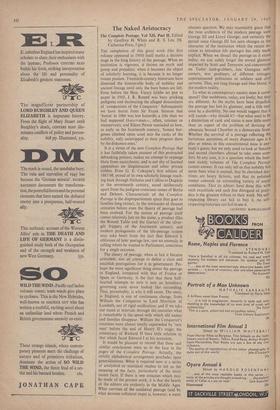The Naked Aristocracy
THE completion of this great work (the first volume appeared in 1910) itself marks a decisive stage in the long history of the peerage. When an institution is vigorous, it thrives on myth and pomp and prejudice; when it becomes the object of scholarly learning, it is because it no longer rouses passion. Twentieth-century historians have dissected the honourable body of nobility and ancient lineage until only the bare bones are left. Even before the Hon. Vicary Gibbs set pen to paper in 1910, J. R. Round was busy pricking pedigrees and decimating the alleged descendants of 'companions of the Conqueror.' Subsequently we have learnt from Sir Frank Stenton that 'baron' in 1066 was less honorific a title than we had supposed (baro=man=, often, retainer or manservant), and Eileen Power reminded us how, as early as the fourteenth century, 'honest bur- gesses climbed upon wool into the ranks of the nobility, only outstripped in their progress there by the dishonest ones.'
It is a virtue of the new Complete Peerage that it has faithfully taken account of this protracted debunking process, makes no attempt to expunge blots from escutcheons, and is not shy of learned appendices on illegitimacies and other private foibles. Even G. E. Cokayne's first edition of 1887-98, proud of its own scholarly lineage reach- ing back through Nicholas and Collins to Dugdale in the seventeenth century, stood deliberately apart from the pedigree-conscious tomes of Burke and Debrett. Characteristic of the Complete Peerage is the disproportionate space that goes to families long extinct, to the intricacies of descent centuries before even the theory of peerage had been evolved. For the notion of peerage itself comes relatively late on the scene, a product (like the Round Table and the Garter) of the silver- gilt frippery of the fourteenth century; and modern protagonists of the life-peerage system may take heart from the fact that Edward 1, oblivious of later peerage law, saw no anomaly in calling whom he wanted to Parliament, sometimes for a single occasion.
The theory of peerage, when at last it became articulate, was an attempt to define a class and establish prerogatives for it in government. Per- haps the most significant thing about the peerage in England, compared with that of France or Spain or Germany, is the fact that these half- hearted attempts to turn it into an hereditary governing caste never looked like succeeding. That, presumably, is why it still exists. The story, in England, is one of continuous change, from William the Conqueror to Lord Morrison of Lambeth, not of rigid ossification; and if we take our stand at intervals through the centuries what is remarkable is theispeed with which old names and families disappear. William the Conqueror's creations were almost totally superseded by 'new men' before the end of Henry II's reign; the aristocracy of Richard II bore little relation to that which faced Edward 1 at his accession.
It would be pleasant to record that these and similar conclusions stare us in the face in the pages of the Complete Peerage. Actually, the strictly alphabetical arrangement precludes most generalisations. What is required now is a series of analytical or statistical studies to tell us the meaning of the facts, particularly of the more
recent facts. If there is one criticism which may be made of the present work, it is that the hearts of the editors are evidently in the Middle Ages. What survives of the mediaeval peerage (and by what devious collateral steps) is, however, a more
obscure question. We may reasonably guess that the twin architects of the modern peerage were George III and Lloyd George; and certainly the period since George III has seen changes in the character of the institution which the recent de- cision to introduce life peerages has only made explicit. When we dissect the peerage as it exists today, we can safely forget the unreal glamour imparted by Scott and Tennyson and concentrate on Tudor land-grabbers, late Georgian mill- owners, war profiteers of different vintages, superannuated politicians or soldiers and civil servants. That, not long lineage and blue blood, is the modern reality.
To what in contemporary society does it corre- spond? Our snobbisms, today, are lively; but they are different. As the myths have been dispelled, the peerage has lost its glamour, and a title may even be a disability. No one would suggest that it will vanish—why should it?—but what used to be a distinction of rank and status is now little more than an aspect of the problem of devising an adequate Second Chamber in a democratic State. Whether the survival of a peerage reflecting the fortuitous accretions of many disparate ages is a plus or minus in this constitutional issue is any guess; but we only need to look at Senates and second chambers abroad to take some com- fort. In any case, it is a question which the four- teen stately volumes of The Complete Peerage cannot answer. It can only tell us that nobility has never been what it seemed, that its cherished doe- trines are hoary fictions, and that its polished veneer conceals an astounding variety of social conditions. That its editors have done this with such exactitude and such fine disregard of preilk dice is the greatest tribute to their work. No self- respecting library can fail to buy it, no self- respecting historian can fail to use it.
.GEOFFREY BARRACLOUGH






































 Previous page
Previous page